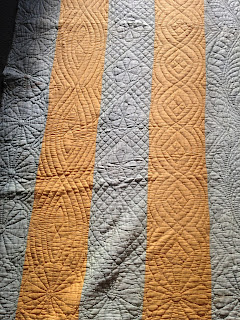I bought this quilt recently.....not in good shape, but with some good history and dated, so very interesting to me from a fabric dating point of view.
The label reads, as best I can make it out - This quilt was made by Katy Low in 1861 under her Mother's (???direction??) for her great Grandmother. After her death it was given to her Grandmother who now gives it to her Katy Low. Dec 1867
This quilt is Welsh in origin, the sellers bought it at auction about 25 years ago.
Many of the fabrics have disintegrated. The seller thought that this was because they were silk dress fabrics, but it fact the rotting is due to a problem called tendering which is caused by the presence of iron oxide used in the printing process for cotton fabrics. The problem is at its worst with dark brown cotton fabrics.
Barbara Brackman on page 99 of her book America's Printed Fabrics 1770-1890, says the following:
Madder style prints - Madder is vegetable dye derived from......Rubia tinctorium.
Cottons dyed with madder are among the most common fabrics in nineteenth-century quilts.....it was colorfast and inexpensive, yet versatile.....producing colors ranging from red-orange through purple, brown and almost black.
Then on page 101 she states: Madder browns and near blacks have an unfortunate tendancy to deteriorate or "tender" fabric. Iron used in the mordanting process interacts with oxygen in the air, essentially rusting the fabric over time. Antique quilts are full of madder-style prints that have oxydised, leaving holes in calicoes and empty lines in stripes. The darker the brown, the more iron in the mordant, and the more likely the fabric is to rot over time.
Here, you can see that the thin border of dark brown has almost completely disappeared over time, exposing the woollen wadding.
This stripe in brown has also disappeared over time.
The backing of the quilt is in linen, common in quilts of this era.
Quilting patterns seen are chevrons in the border, while the blocks are outlined and then filled with a scale or clamshell pattern.
There is a variety of patterns to be seen. Phillip Sykas told us that most quilts seem to have a ten year spread of fabrics, although some quilts do seem to be made from scrap bags containing some much older fabrics.
In addition, bundles of fabric pieces were readily available at markets, along with tradesmens sample books which could be also turned into patchwork. In this quilt, although the squares are varied, many have a twin, suggesting that the fabrics were bought in, or perhaps came from a seamstress' supply.
Larger amounts of fabrics were needed for the inner and outer borders.
This quilt is entirely hand pieced. The sewing machine was not available at the time this quilt was made...the stitches are tiny. This is especially evident on the binding, in which the backing linen is brought to the front and fixed with tiny stitches.
There are some attractive blue colours to be seen, probably Prussian Blue. The red and orange fabrics are all madder style, with no turkey red fabrics to be seen. The fabrics are mostly roller prints. Artificial fabric dyes did not exist at this time.











































